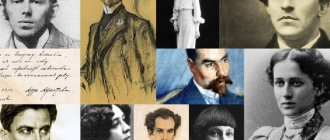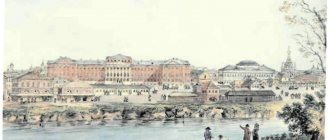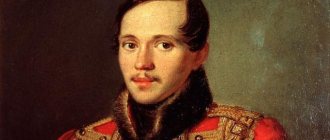4.1
Average rating: 4.1
Total ratings received: 221.
4.1
Average rating: 4.1
Total ratings received: 221.
The realistic direction occupies a special place in literature. In this article we will indicate the representatives of realism in literature and their most striking realistic works.
Representatives
At the origins of realism in Russian literature are I. A. Krylov with his numerous fables and A. S. Griboedov with his comedy “Woe from Wit.”
A. S. Pushkin and N. V. Gogol are prominent representatives of realism of the 19th century. The work of these writers is multifaceted: from romanticism, which reigned at that time, they gradually moved to realism in order to reliably reflect pressing problems.
A. S. Pushkin is considered the founder of Russian realism.
Among the realistic works of A. S. Pushkin, one can highlight the story “The Captain's Daughter”, the novel “Dubrovsky”, and the historical drama “Boris Godunov”. Features of realism can be seen in the novel in verse “Eugene Onegin”, the poem “The Bronze Horseman”.
The features of romanticism are combined with the features of realism in M. Yu. Lermontov’s novel “A Hero of Our Time.”
Rice. 1. Realism in literature
N.V. Gogol, continuing the traditions of realistic depiction, writes the comedy “The Inspector General” and the poem “Dead Souls.”
Prominent representatives of realism as a literary movement are I. A. Goncharov (“Oblomov”), I. S. Turgenev (“Fathers and Sons”, “Rudin”), F. M. Dostoevsky (“Crime and Punishment”, “Poor People” ").
When modernism began to emerge (late 19th century), the realistic movement still occupied a special place. The works of L. N. Tolstoy (“War and Peace”, “Anna Karenina”), A. P. Chekhov (“The Cherry Orchard”, “Man in a Case”), A. I. Kuprin (“Olesya”, “Pomegranate”) stand out bracelet"), M. Gorky ("At the Depth", "Mother").
Realism in Russian literature of the 19th century
Realism replaced the previously dominant romanticism in literature. In Russia, realism originated in the 1830s, reaching its peak by the middle of the century. Realist writers consciously refused to use any sophisticated techniques, mystical ideas or attempts to idealize a character in their works. Realists use ordinary, sometimes even everyday images, transferring the real person as she is onto the pages of their books.
As a rule, works written in the spirit of realism are distinguished by their life-affirming beginning. Unlike romantic works, in which the acute conflict between the hero and society rarely ended in anything good.
Finished works on a similar topic
Course work Realism in Russian literature 440 ₽ Essay Realism in Russian literature 250 ₽ Examination Realism in Russian literature 200 ₽
Receive completed work or specialist advice on your educational project Find out the cost
Note 1
Realism sought to find truth and justice, to change the world for the better.
Separately, it is worth highlighting critical realism, a direction that actively developed in the middle of the 19th century and soon became leading in literature.
The development of Russian realism is associated primarily with the names of A.S. Pushkin and N.V. Gogol. They were among the first Russian writers who moved from romanticism to realism, to a reliable, rather than idealized, depiction of reality. In their works, the lives of the heroes for the first time began to be accompanied by a detailed and realistic social background.
Note 2
A.S. Pushkin is considered the founder of Russian realism.
Pushkin was the first to convey on the pages of his works the essence of the most important events in the life of a Russian person, presenting them as they were - vivid and, most importantly, contradictory. The analysis of the internal experiences of the characters deepens, the inner world becomes richer and wider, the characters themselves become more alive and close to real people.
Russian realism of the 19th century was characterized by increased attention to the socio-political life of Russia. At that time, the country was experiencing great changes and was on the verge of abolishing serfdom. The fate of the common people, the relationship between man and government, the future of Russia - all these themes are found in the works of realist writers.
The emergence of critical realism, the purpose of which was to address the most pressing issues, is directly related to the situation in Russia.
Some works of Russian realist writers of the 19th century:
- A.S. Pushkin - “The Captain’s Daughter”, “Dubrovsky”, “Boris Godunov”;
- M.Yu. Lermontov - “Hero of Our Time” (with features of romanticism);
- N.V. Gogol - “Dead Souls”, “The Inspector General”;
- I.A. Goncharov - “Oblomov”, “Ordinary History”;
- I.S. Turgenev - “Fathers and Sons”, “Rudin”;
- F.M. Dostoevsky - “Crime and Punishment”, “Poor People”, “Idiot”;
- L.N. Tolstoy - “Anna Karenina”, “Sunday”;
- A.P. Chekhov - “The Cherry Orchard”, “Man in a Case”;
- A.I. Kuprin - “Olesya”, “Garnet Bracelet”, “Pit”.
20th century realism in literature
3.4
(13)
Realism as a method arose in Russian literature in the first third of the 19th century. The main principle of realism is the principle of life truth, the reproduction of characters and circumstances explained socio-historically (typical characters in typical circumstances).
Realist writers deeply and truthfully depicted various aspects of contemporary reality, recreated life in the forms of life itself.
The basis of the realistic method of the early 19th century is made up of positive ideals: humanism, sympathy for the humiliated and offended, the search for a positive hero in life, optimism and patriotism.
By the end of the 19th century, realism reached its peak in the works of such writers as F. M. Dostoevsky, L. N. Tolstoy, A. P. Chekhov.
The twentieth century set new tasks for realist writers and forced them to look for new ways to master life material. In the conditions of rising revolutionary sentiments, literature was increasingly imbued with forebodings and expectations of impending changes, “unheard-of rebellions.”
The feeling of approaching social changes evoked such an intensity of artistic life that Russian art had never known before. Here is what L.N. Tolstoy wrote about the turn of the century: “The new century brings the end of one worldview, one faith, one way of communicating between people and the beginning of another worldview, another way of communication. M. Gorky called the 20th century the century of spiritual renewal.
At the beginning of the twentieth century, the classics of Russian realism L.N. continued their search for the secrets of existence, the secrets of human existence and consciousness. Tolstoy, A.P. Chekhov, L.N. Andreev, I.A. Bunin and others.
However, the principle of old realism was increasingly criticized by various literary communities, which demanded a more active intervention of the writer into life and influence on it.
This revision was started by L.N. Tolstoy himself, who in the last years of his life called for strengthening the didactic, instructive, preaching principle in literature.
If A.P. Chekhov believed that the “court” (i.e., the artist) is obliged only to raise questions, to focus the attention of the thinking reader on important problems, and the “jury” (social structures) is obliged to answer, then for the realist writers of the early twentieth century century, this no longer seemed sufficient.
Thus, M. Gorky directly stated that “for some reason the luxurious mirror of Russian literature did not reflect the outbursts of popular anger ...”, and accused literature of the fact that “it did not look for heroes, it loved to talk about people who were strong only in patience, meek , soft, dreaming of paradise in heaven, silently suffering on earth.”
It was M. Gorky, a realist writer of the younger generation, who was the founder of a new literary movement, which later received the name “socialist realism.”
The literary and social activities of M. Gorky played a significant role in uniting realist writers of the new generation. In the 1890s, on the initiative of M. Gorky, the literary circle “Sreda” appeared, and then the publishing house “Znanie”. Young, talented writers A.I. gather around this publishing house. Kuprii, I.A. Bunin, L.N. Andreev, A. Serafimovich, D. Bedny and others.
The debate with traditional realism was waged at different poles of literature. There were writers who followed the traditional direction, seeking to update it. But there were also those who simply rejected realism as an outdated direction.
In these difficult conditions, in the confrontation of polar methods and trends, the creativity of writers traditionally called realists continued to develop.
The originality of Russian realistic literature of the early twentieth century lies not only in the significance of the content and acute social themes, but also in artistic quests, perfection of technology, and stylistic diversity.
Here are the features of expressionism (e Red Laughter, “Judas Iscariot” by L. N. Andreev), and ornamental prose with skillful stylization (the work of A. Remizov, E. Zamyatin), and rhythmic prose (“Petersburg” by A. Bely), and special, “condensed realism” with its precise and expressive language (prose by I. A. Bunin).
And yet, the main, decisive thing in Russian literature of the early twentieth century remained how deeply and correctly it comprehended vital problems, how high its moral ideal was.
3.4 / 5. 13
.
Realism in Russian works
In Russia, its development began in the 1830s and was a consequence of the conflict situation in various spheres of society, the contradictions between higher ranks and ordinary people. Writers began to turn to pressing issues of their time.
Thus begins the rapid development of a new genre - the realistic novel, which, as a rule, described the hard life of ordinary people, their hardships and problems.
The initial stage in the development of the realistic trend in Russian literature is the “natural school”. During the period of the “natural school,” literary works tended to a greater extent to describe the position of the hero in society, his belonging to some kind of profession. Among all genres, the leading place was occupied by the physiological essay .
In the 1850s–1900s, realism began to be called critical, since the main goal was to criticize what was happening, the relationship between a certain person and spheres of society. Issues such as: the measure of the influence of society on the life of an individual, actions that can change a person and the world around him, the reason for the lack of happiness in human life were considered.
Realism in Russian works
This literary trend has become extremely popular in Russian literature, as Russian writers were able to make the world genre system richer. Works emerged with in-depth questions of philosophy and morality .
I.S. Turgenev created an ideological type of heroes, the character, personality and internal state of which directly depended on the author’s assessment of the worldview, finding a certain meaning in the concepts of their philosophy. Such heroes are subject to ideas that they follow until the very end, developing them as much as possible.
In the works of L.N. Tolstoy, the system of ideas that develops during the character’s life determines the form of his interaction with the surrounding reality and depends on the morality and personal characteristics of the heroes of the work.
Founder of realism
The title of pioneer of this trend in Russian literature was rightfully awarded to Alexander Sergeevich Pushkin. He is the generally recognized founder of realism in Russia. “Boris Godunov” and “Eugene Onegin” are considered striking examples of realism in Russian literature of those times. Also distinguishing examples were such works by Alexander Sergeevich as “Belkin’s Tales” and “The Captain’s Daughter”.
Classical realism gradually begins to develop in Pushkin’s creative works. The writer’s portrayal of the personality of each hero is comprehensive in an effort to describe the complexity of his inner world and state of mind , which are revealed very harmoniously. Recreating the experiences of a certain person, his moral character helps Pushkin overcome the self-will of describing passions inherent in irrationalism.
Heroes A.S. Pushkin appear before readers with open sides of their being. The writer pays special attention to describing the aspects of the human inner world, depicts the hero in the process of development and formation of his personality, which are influenced by the reality of society and the environment. This was due to his awareness of the need to depict a specific historical and national identity in the characteristics of the people.



